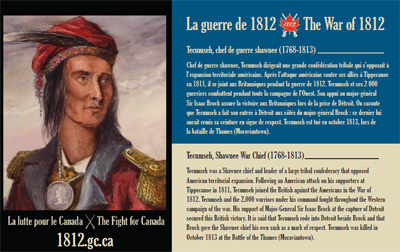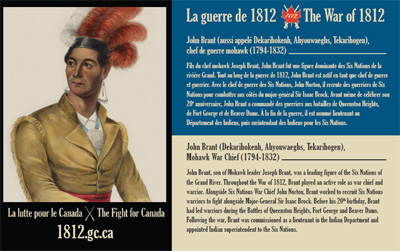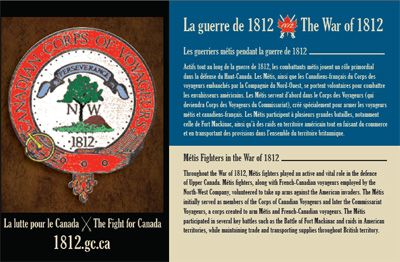War of 1812 Postcards
Tecumseh
Author: Minister of Aboriginal Affairs and Northern Development
Date: 2012
QS-: 6276-000-BB-A1
PDF Version (993 Kb, 2 Pages)

Tecumseh, Shawnee War Chief (1768-1813)
Tecumseh was a Shawnee chief and leader of a large tribal confederacy that opposed American territorial expansion. Following an American attack on his supporters at Tippecanoe in 1811, Tecumseh joined the British against the Americans in the War of 1812. Tecumseh and the 2000 warriors under his command fought throughout the Western campaign of the war. His support of Major-General Sir Isaac Brock at the capture of Detroit secured this British victory. It is said that Tecumseh rode into Detroit beside Brock and that Brock gave the Shawnee chief his own sash as a mark of respect. Tecumseh was killed in October 1813 at the Battle of the Thames (Moraviantown).
To order the Tecumseh postcard, go to the Publication Catalogue.
John Brant (Dekarihokenh, Ahyouwaeghs, Tekarihogen)
Author: Minister of Aboriginal Affairs and Northern Development
Date: 2012
QS-: QS-6277-000-BB-A1
PDF Version (666 Kb, 2 Pages)

John Brant, Mohawk War Chief (1794-1832)
John Brant, son of Mohawk leader Joseph Brant, was a leading figure of the Six Nations of the Grand River. Throughout the War of 1812, Brant played an active role as war chief and warrior. Alongside Six Nations War Chief John Norton, Brant worked to recruit Six Nations warriors to fight alongside Major-General Sir Isaac Brock. Before his 20th birthday, Brant had led warriors during the Battles of Queenston Heights, Fort George, and Beaver Dams. Following the war, Brant was commissioned as a lieutenant in the Indian Department and appointed Indian superintendent to the Six Nations.
To order the John Brant postcard, go to the Publication Catalogue.
Métis Fighters in the War of 1812
Author: Minister of Aboriginal Affairs and Northern Development
Date: 2012
QS-: QS-6278-000-BB-A1
PDF Version (1.02 Mb, 2 Pages)

Métis Fighters in the War of 1812
Throughout the War of 1812, Metis fighters played an active and vital role in the defence of Upper Canada. Metis fighters, along with French-Canadian voyageurs employed by the North-West Company, volunteered to take up arms against the American invaders. The Metis initially served as members of the Corps of Canadian Voyageurs and later the Commissariat Voyageurs, a corps created to arm Metis and French-Canadian voyageurs. The Metis participated in several key battles such as the Battle of Fort Mackinac and raids in American territories, while maintaining trade and transporting supplies throughout British territory.
To order the Metis Fighters in the War of 1812 postcard, go to the Publication Catalogue.
John Norton (Teyoninhokarawen or "the Snipe")
Author: Minister of Aboriginal Affairs and Northern Development
Date: 2012
QS-: QS-6281-000-BB-A1
PDF Version (875 Kb, 2 Pages)

John Norton (Teyoninhokarawen or "the Snipe"), Six Nations War Chief (ca. 1765-1831)
John Norton, son of a Cherokee father and Scottish mother, joined the British Army as a young man and served in British North America. After deserting the army, he was adopted by the Mohawk Nation and rose to become a diplomat and war chief. During the War of 1812, Norton recruited Six Nations and Delaware warriors to assist Major-General Sir Isaac Brock on the Niagara frontier, where they played a key role in the defeat of the Americans at Queenston Heights. Along with Six Nations War Chief John Brant, Norton commanded warriors at the battles of Fort George, Stoney Creek and Beaver Dams.
To order the John Norton postcard, go to the Publication Catalogue.
Chief Oshawana (John Naudee)
Author: Minister of Aboriginal Affairs and Northern Development
Date: 2012
QS-: QS-6282-000-BB-A1
PDF Version (760 Kb, 2 Pages)

Chief Oshawana (John Naudee), Walpole Island
From Walpole Island on Lake St. Claire, Oshawana, also known as John Naudee, had close links throughout both British and American territories. A long-time supporter of Tecumseh's efforts to create a strong confederacy against the Americans, Oshawana participated in several battles on the Western Frontier such as Frenchtown, Fort Detroit and Fort Meigs alongside numerous warriors from Walpole Island. He was often described as Tecumseh's chief warrior. After the death of Tecumseh at the Battle of the Thames, Oshawana became the principal First Nation warrior of southwestern Upper Canada and continued to support the British until the very end of the war.
To order the Chief Oshawana postcard, go to the Publication Catalogue.
Wabasha (Waa-Pa-Shaw IV)
Author: Minister of Aboriginal Affairs and Northern Development
Date: 2012
QS-: QS-6283-000-BB-A1
PDF Version (616 Kb, 2 Pages)

Wabasha (Waa-Pa-Shaw IV), Dakota, Captain and War Chief (ca. 1765/77-1836)
Wabasha, also known as Waa-Pa-Shaw IV, was chief of a Kiowa tribe of the Mdewakanton and was highly respected by the Dakota. Called to support the British against American aggressions, Wabasha led a strong contingent of Dakota warriors to Fort St. Joseph near Sault Ste. Marie. Alongside other First Nation warriors, Wabasha participated in key battles during the War of 1812, including the Battle of Fort Mackinac and Fort Meigs, as well as others throughout the western frontier. After the Treaty of Ghent, Wabasha continued to be an important spokesperson for the Dakota and his people's rights against growing American expansionism.
To order the Wabasha postcard, go to the Publication Catalogue.